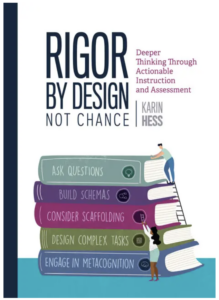How to Implement Rigor by Design, Not Chance
Rigor by Design, Not Chance: Deeper Thinking Through Actionable Instruction and Assessment
By Karin Hess
(ASCD, 2023 – Learn more)
Reviewed by Kathleen Palmieri
 One of the cornerstones to my own recent research has been finding strategies to increase student engagement and rigor in the classroom. In her book Rigor by Design, Not Chance Dr. Karin Hess has graciously shared her extensive research and findings with a lens on student engagement, understanding, and assessment.
One of the cornerstones to my own recent research has been finding strategies to increase student engagement and rigor in the classroom. In her book Rigor by Design, Not Chance Dr. Karin Hess has graciously shared her extensive research and findings with a lens on student engagement, understanding, and assessment.
As I take a deeper dive into my own practice, I appreciate how Hess provides many strategies (with excellent rationales) to help teachers both engage and challenge their students.
Planning student centered instruction is a major element in increasing rigor in learning, and Hess offers important information on how the brain functions, specifically its need to find patterns and make connections leading to deeper learning. What I’ve noticed in my own classroom, and appreciated in Hess’ writing, is that the increasing complexity of the content can become overwhelming for students and create a disconnect in their learning.

According to Hess, “Deeper learning goes beyond acquiring and applying facts, concepts, and skills. It requires students to know themselves better as learners; They need to begin to see themselves as problem solvers and as critical, creative thinkers.” (p. 1)
Essentials to creating rigorous learning
Hess poses and answers several questions that are important to increasing rigor. She includes why we should strategically scaffold learning, design complex tasks for all students, and engage students in metacognition and reflection through the “Learning Process.”
Hess unfolds her research as a foundation for understanding the true meaning of the term “rigor.” She also shares five essential, evidence-based teacher moves to “build a supportive classroom culture for thinking and learning” using an acronym of the ABC’s. (p.2) They are as follows:
✻ Ask a series of probing questions of increasing complexity.
✻ Build schemas in each content area.
✻ Consider ways to strategically scaffold learning.
✻ Design complex tasks that emphasize transfer and evidence-based solutions.
✻ Engage students in metacognition and reflection throughout the learning process.
These five essential teacher moves are the catalyst for the learning journey you’ll take as you read. Each is defined, unpacked, and supported by research providing a rationale for each. The final chapter pulls it all together by providing three important perspectives.
The first is the students’ perspective, which involves the expectations on learning. Next is the teacher’s perspective focusing on the planning, implementation, and assessment to include the five essential teacher moves (the ABCDE). Finally, the “system perspective” includes leaders and instructional coaches who often observe and assess questioning in the classroom, the learning environment, and the levels of engagement.
Points for reflection
Finally, I’d like to offer some takeaways that I will reflect upon and return to often from Hess’s research and writing.
► First, in chapter 2, “Ask a Series of Probing Questions,” the section on “Tips for Effective Questioning” provides excellent questioning techniques and strategies. (pp. 34-37)
► Next, in chapter 5, “Designing Complex Tasks,” Hess offers five key questions to frame your thinking as to scope and intended depth of learning, which to me is a must-have prior to creating new activities or rubrics. (p.100)
► Then, in chapter 6, “Engage Students in Metacognition and Reflection,” Hess unfolds five interrelated components of self-direction in the section on “Self-Reflection by Design” (pp. 134-135)
A book such as Rigor by Design, Not Chance: Deeper Thinking Through Actionable Instruction and Assessment by Karin Hess is a must read for every educator. It is well researched, clear in providing the essentials to increase rigor and engagement, and timely in helping educators plan for the deeper learning that is needed now more than ever to build lifelong learners.
Learn
5 Metacognitive Tools to Reveal Hidden Learning
in Karin Hess’s MiddleWeb article.
Kathleen Palmieri is a National Board Certified Teacher and NBCT Professional Learning facilitator. She is a fifth grade educator in upstate New York who reviews and writes regularly for MiddleWeb. With a passion for literacy and learning in the classroom, she participates in various writing workshops, curriculum writing endeavors, and math presentations.
As a lifelong learner, Kathie is an avid reader and researcher of educational practices and techniques. She collaborates with colleagues and globally on Twitter @Kathleen Palmieri NBCT and expands her education adventures at her personal blog www.kathleenpalmieri.com.





































Thank you, Kathleen, for your thoughtful (and complimentary) review. I’m always curious as to which ideas resonate with readers and your review did not disappoint – you’ve captured many ideas I was hoping to reinforce. I’ve just developed a book study guide. which will make those resources at the end of every chapter easier to access…if you – or any readers – would like a copy, contact me via my website http://www.karin-hess.com
Karin, thank you so very much for the excellent book. I very much enjoyed reading and easily reviewing it. I will definitely contact you through your website.